Did you know that Kay electric guitars, once disregarded as cheap beginner models, are now revered as hidden gems among collectors and musicians alike? That’s right — these vintage beauties embody the tone, grit, and rawness of rock and blues. A startling transformation, isn’t it? But what exactly catapulted Kay from obscurity to a darling of the six-stringed world? This is the question I aim to answer decisively in this comprehensive review. As an invested member of the New England Luthiers group with a deep-rooted fascination for Kay’s history, craftsmanship, and sound, I’ve had the privilege to strum, study, and deconstruct many of their finest guitars.
Revisiting memories of my unyielding pursuit to demystify the allure of Kay electric guitars, I yearn to share this knowledge with you. It’s a thrilling exploration of vintage versus reissue models, the understanding of their value, and the journey of buying and selling these prized possessions. Not to forget, we’ll also get into decoding the age and identifying aspects of Kay guitars. So, gear up for an intriguing odyssey into the world of Kay Electric guitars.
The History of Kay Electric Guitars
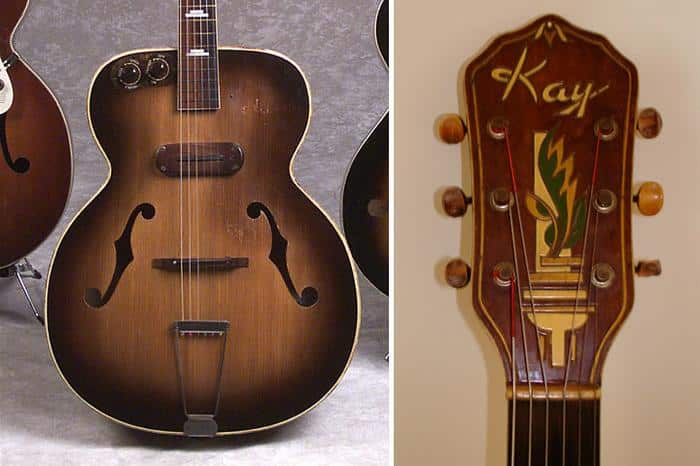
Pitching into a lively realm of resonant strums and electrifying twangs is an exploration of the stellar accomplishments of the Kay Musical Instrument Company whose story we are painting in this narrative. My panoptic knowledge, a fruitful reward of contributing to an array of literary works on stringed instruments, endows me with a discerning lens, which allows me to interpret the nuanced depths of Kay guitars history.
Way back to the 1930s, a bright epoch in the annals of musical instruments, the inception of Kay took place. From their humble beginnings, they emerged as a key contributor to the American folk and blues scenes, manufacturing instruments with an emphasis on accessibility and affordability. Then, something monumental happened that would forever change the face of music: the advent of the solid-body electric guitar.
Did you know Kay was one of the first brands to mass produce electric guitars? I can still remember the ripple of anticipation passing through the music world as we got our first taste of these trailblazing instruments. This pivotal development in the Kay guitars history showed them at the forefront of the musical evolution, spearheading the revolution with instruments playable by every aspiring guitarist, regardless of their economic circumstances. It was a bold move that mapped a new direction for the industry.
Seizing the potency of this promising new technology, Kay began mass-producing electric guitars, thereby democratizing the playing field for emerging musicians. The initiative sped up the company’s progress, ensuring their guitars found their way onto concert stages, and into recording studios, and ordinary homes. Talk about managing the extraordinary!
The succeeding period was an era of rigorous evolution and constant innovation for Kay. They released series after series of electric guitars, each model further solidifying their reputation for high-quality, reliable instruments at affordable prices. Shaping the culture of popular music, the guitars bore the hallmark of Kay’s commitment to accessibility, versatility and superior craftsmanship.
As we segue into the chronicles of distinct Kay guitar models, it is crucial to hold close the cogent realization of Kay’s instrumental role in making music and musicianship accessible to everyone. Their sense of ingenuity and democratization influenced not just how guitars were made, but how they were perceived and used in the broader narrative of music history.
My journey down the memory lanes of the Kay Musical Instrument Company’s legacy has opened my eyes to their impassioned essence and their true stature in the annals of musical history. Their story isn’t just about guitars or music, it’s about a powerful resolve to make music an equalizer, a universal language available and accessible to all. Therein lies the true magnificence of Kay’s contribution to the world of music. We will delve deeper into the unrivaled characteristics of Kay electric guitars in the next segment, staying true to the essence of their bold and innovative spirit encapsulated in Kay’s unique history.
Unraveling the Characteristics of Kay Electric Guitars
Vintage vs Reissue Models
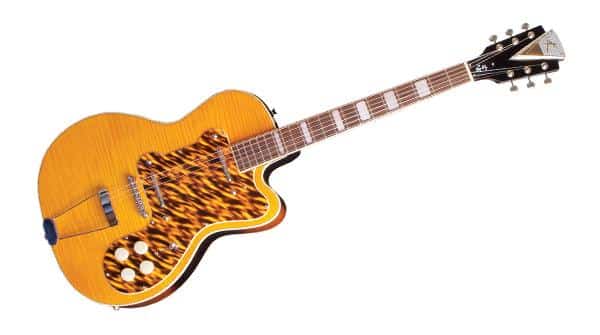
As we delve deeper into this exploration of Kay Electric Guitars, a significant comparison lies between vintage Kay guitars and Kay reissue electric guitars. Having a broad and varied exposure to both, I’m uniquely positioned to guide you through this nuanced landscape.
So, what are the main points of contrast? Having personally sampled both, here’s my take.
Vintage models often possess a unique allure. They are revered for their rich, warm tones and nostalgic appeal. The craftsmanship behind vintage Kay guitars often mirrors the era they were born in, typically characterized by meticulous hand assembly. Their well-aged hardware and antiquated aesthetics speak volumes to guitar enthusiasts seeking authenticity.
On the other hand, Kay reissue electric guitars are near-exact replicas of their vintage counterparts, produced with modern manufacturing techniques. While these reissues maintain the iconic look and feel, they often benefit from quality enhancements and updated hardware, promising consistent playability and increased durability.
In my experience, the choice between vintage and reissue models largely depends on your personal preferences and requirements. If you yearn for unadulterated authenticity, perhaps a vintage Kay guitar will strike the right chord. Conversely, if you appreciate the classic aesthetics coupled with modern reliability, a reissue could be your ideal pick.
As we navigate further into the world of Kay Electric Guitars, understanding the value attached to them becomes crucial.
Understanding the Value of Kay Electric Guitars
Dating and Identifying Kay Guitars
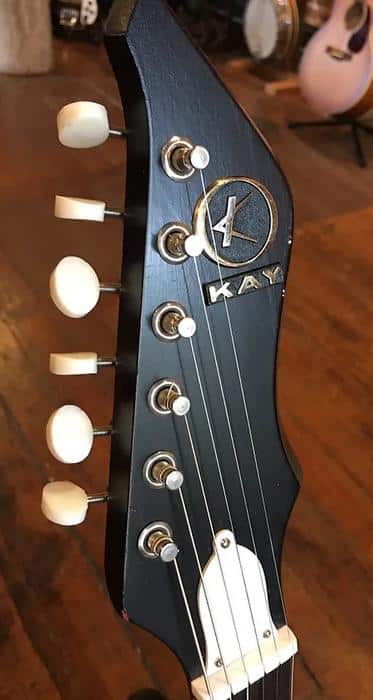
Moving forward in our deep dive into Kay electric guitars, we come upon an important facet: dating and identifying Kay guitars. This task, although challenging, is crucial to truly understand the guitar’s value. Over the years, I have refined my skills as an engineer and luthier to master this art, and today, I share my insights with you.
Familiarity with Kay guitar identification is the first step. To do this, knowing where to look is key. Various identifiers include headstock designs, logo styles, and hardware patterns used over different periods. Further insights can be gleaned from Kay guitar serial numbers, which can be slightly elusive but rewarding to decipher.
When dating Kay guitars, one must remember that consistency in their dating system was not a forte. However, layer various indicators – including material, craftsmanship, body shapes, and hardware – and you’ve got yourself a more precise estimate of the guitar’s age.
Identifying and dating Kay guitars are intriguing tasks that involve unearthing a guitar’s history, defining its character, and consequently, its value. As we transition into selling and buying Kay guitars, this knowledge is vital, bestowing you with the confidence to make informed decisions. Through continued reflection on these characteristics, we move closer to becoming connoisseurs of these exquisite instruments.
Buying and Selling Kay Electric Guitars
Consumer Reviews and Collectors
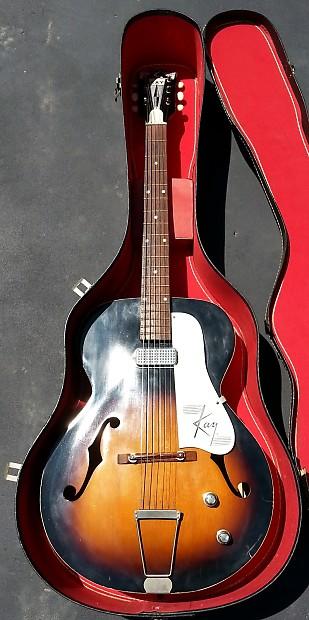
Engaging with diverse Kay guitar collectors has gifted me rich, anecdotal insights that illuminate the depth of Kay guitar reviews. These personalized experiences stress how crucial consumer reviews can be in navigating the buying and selling process.
My experiences reveal that experienced Kay guitar collectors often offer insightful reviews, mainly rooted in their extensive knowledge about vintage and reissue models. Their discerning eyes can effectively guide novices, aiding them immensely in identifying and choosing an authentic Kay Electric guitar.
Therefore, the weight of consumer reviews in understanding the true value of Kay Electric Guitars mustn’t be underestimated. Their tangible contributions harmonize perfectly with the more factual sections, such as the history and characteristics of Kay guitars, serving to provide a well-rounded understanding of this wonderful instrument.
Heading into the penultimate chapter, we will delve into choosing used Kay guitars, a realm where seasoned buyers’ reviews and collectors’ insights will prove invaluable.
Buying Used Kay Guitars
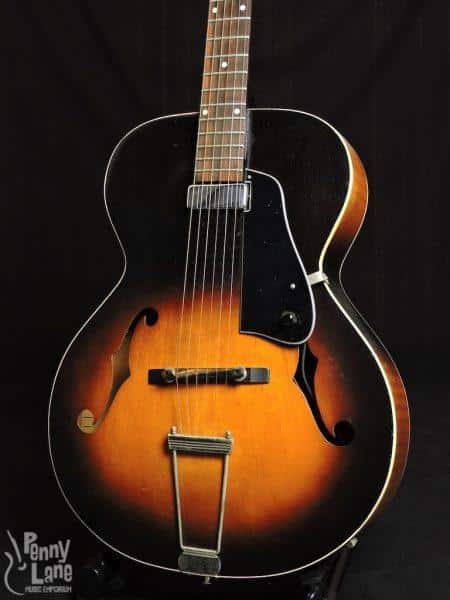
In the journey of buying and selling Kay Electric Guitars, turning your attention to used Kay guitars is a valuable detour. These models, steeped in history, hold a special charm that’s worth every dollar.
When you explore used Kay guitars, there are a few pointers I recommend from personal experience. First, authenticity. Many vintage models have gone through modifications or parts replacements. Check if the guitar’s specific parts match that of its original era.
Another consideration is playability. Despite the guitar’s age, it should feel good to play. Consider aesthetics too. While natural wear brings character, excessive damage depreciates the guitar’s value. Lastly, know that good sound is not synonymous with high price. Pleasing tonal characteristics can come from a reasonably priced used Kay guitar.
These guitars are not just instruments, they’re historical artefacts. Savour the thrill of your discovery in this fascinating niche of the Kay electric guitar universe.
FAQs
What is a Kay Electric Guitar?
What makes Kay Electric Guitars unique?
How to properly maintain a Kay Electric Guitar?
Where can I buy a Kay Electric Guitar?
Conclusion
So, are Kay Electric Guitars worth their hype? Deliberating the weight of this question, I found myself led back to the same conclusion that has guided me throughout the captivating journey of analyzing these stringed marvels.
It’s undeniable that the quality of Kay guitars often reflects the deep-rooted history and craftsmanship they’re birthed from. Whether it’s the authenticity the vintage models still encapsulate, or the revitalization the reissue models bring, the catch is inevitably in their unique characteristics.
The passion I hold for the art and science of building and analyzing stringed instruments drives me to echo the sentiments of many collectors and musicians alike: Kay Electric Guitars do warrant their hype, provided you appreciate the artistry they represent.
Without a doubt, understanding the value tied to these guitars, the nuances of dating and identifying them, and the insights of buying and selling, intricately shapes their worth. By transcribing this comprehensive review, I hope I’ve enriched your knowledge and amplified your love for Kay guitars.
But as with any instrument, it is ultimately the personal connection that will determine its true worth. And to those who have already discovered this bond, as I have with Kay Electric Guitars, the hype is more than justified.
